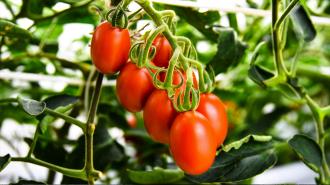This article is an installment of Future Explored, a weekly guide to world-changing technology. You can get stories like this one straight to your inbox every Thursday morning by subscribing here.
Using the powerful gene-editing tool CRISPR, researchers are altering crops and animals to add desirable traits and remove undesirable ones.
Many of these edited plants and animals could appear in nature — due to a rare mutation, for example — setting them apart from the many GMOs that probably couldn’t arise naturally, such as the disease-resistant honeysweet plum, which contains a gene from the plum pox potyvirus (PPV).
This not only eases the path to regulatory approval, but could also help encourage public acceptance — a key part of getting CRISPR’d foods out of the lab and onto plates.
Here are some of the ways scientists are using CRISPR to create healthier, more appealing, and more resilient foods — putting us closer to a future in which every person not only has access to the healthy foods they need, but actually wants to eat those foods, too.
Boosted tomatoes
In September 2021, Japanese startup Sanatech Seed began selling the first CRISPR’d food to reach the consumer market: a variety of tomatoes containing high amounts of gamma aminobutyric acid (GABA).
GABA is a compound produced naturally in our brains. Research has linked it to reduced feelings of stress and anxiety, and some scientists suspect that increasing GABA levels may be able to treat high blood pressure, insomnia, and other health problems, too.
Rather than taking supplements, people in Japan can now increase their GABA intake by eating Sanatech’s tomatoes, which have been edited to produce less of an enzyme that breaks down the fruit’s natural GABA.

Super grains
According to the UN, we’ll need to produce 50% more food by 2050 to feed the growing population. We’re already using most of our high quality farmland, though, so we need to figure out how to produce more food on the same amount of land — and CRISPR can help.
Using CRISPR, researchers in China and Germany silenced a gene that restrains kernel production in corn. This increased the number of kernel rows on an ear from 14 to 16, leading to a 10% increase in crop yields. Silencing a comparable gene in rice increased yields by 8%.
Given that corn and rice already account for more than one-third of the calories consumed globally, these edited varieties could be hugely beneficial to the world’s food supply in the future.
Tastier greens
Mustard greens are a low-calorie, nutrient-dense leafy vegetable, but they have a distinctly bitter flavor caused by a reaction between two components — and that flavor can discourage some grocery shoppers from putting the healthy veggie in their carts.
“People want healthy salads, but they keep buying romaine because they’re used to the flavor,” Tom Adams, CEO of food-tech startup PairWise, told Singularity Hub.
Using CRISPR, Pairwise edited out one of the two bitterness-causing components, creating mustard greens with a milder taste. The FDA has already approved the greens, and shoppers in California and the Pacific Northwest should start to see them in the produce section in 2023.
Climate-resistant cattle
Most of the CRISPR’d foods in development are crops, but in March 2022, the FDA gave researchers at Recombinetics, a Minnesota bioengineering company, the greenlight to market a genome-edited beef cattle for consumption.
Some cattle in subtropical and tropical areas have a rare, but naturally occurring genetic variant that causes them to develop a “slick” haircoat. Because this coat is shorter and lighter than the standard coat, those cattle are less prone to heat stress, which can be both deadly for cattle and costly for farmers.
Instead of trying to produce beef cattle with this trait this old fashioned way, through imprecise selective breeding, Reombinetics used CRISPR to give beef cattle an inheritable form of the variant, leading to a line of slick-coated beef cattle. At the time of the FDA’s ruling, it said it expected to have meat from its heat-resistant animals ready for consumers within two years.

Prettier potatoes
When you slice or peel a potato, enzymes called “polyphenol oxidases” (PPOs) cause the starches in the tuber to react with the air and turn the potato’s flesh brown — this can affect its nutritional value, as well as make the potato look less appealing.
In 2020, researchers at the Instituto Nacional de Tecnología Agropecuaria Balcarce in Argentina revealed that they’d used CRISPR to silence a gene that instructs cells to produce PPOs, resulting in potatoes with reduced browning.
Field trials are ongoing, with the goal of seeing how the taters perform under normal production conditions. The researchers hope to get enough data from those trials to register the variety with Argentina’s National Institute of Seeds.
Heartier bananas
Banana xanthomonas wilt (BXW) is an easily spread bacterial disease that can affect every species of banana we cultivate. Over the past decade, it has caused billions of dollars in economic losses and threatened the jobs and food security of millions of people.
When a banana plant is infected, its expression of a gene called “downy mildew resistance 6” (DMR6) increases. That suppresses the plant’s immune function, so researchers in Kenya used CRISPR to reduce the expression of DMR6 and create bananas that are resistant to BWX.
The edited bananas appeared no different from unedited varieties, but the researchers note that the fruits still need to prove themselves in field tests — so far, they’ve only been grown in greenhouses.
Fast-growing beef
Meat is in high demand, but the raising and slaughtering of animals is expensive, bad for the environment, and, arguably, unethical. Cultivated meat grown from cells in bioreactors could help solve these problems without forcing people to give up “real” meat.
It’s still way more expensive to cultivate meat than to raise it on a farm, though — but by using CRISPR to make tiny changes to beef cells, alt-meat startup SCiFi Foods says it’s encouraging the cells to grow at a larger scale in the lab while also cutting costs.
The company is still going through the process of getting its products — a mix of cultivated and plant-based meats — approved by regulators, but it expects to be ready to launch a burger in 2024.

Looking ahead
CRISPR gene editing was only invented a decade ago, and we’re already starting to see remarkable new CRISPR’d foods reach consumers’ plates, suggesting that it might not be long before the average grocery store is carrying products boosted by the tech.
Combined with innovations like vertical farms, plants that grow in the dark, and sustainable proteins inspired by space travel, the future of food is looking more secure — and sci-fi — than our ancestors ever could have imagined.
We’d love to hear from you! If you have a comment about this article or if you have a tip for a future Freethink story, please email us at [email protected].






